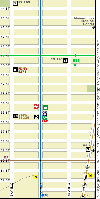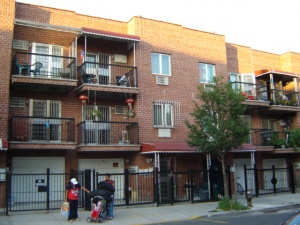Chinese in NYC
From The Peopling of NYC
Contents |
Chinese Immigration in New York City
In the 1880s, due to increasing discrimination and violence against the Chinese for stealing American jobs, Chinese immigrants moved from the West Coast to the East Coast. They settled in large cities where there were more employment opportunities and where they could easily blend in with the diverse population. In these cities, they opened hand laundromats, worked in garment factories, and established Chinatowns. One of them was New York City, in which three Chinatowns were created – the original one in Manhattan, one in Queens, and one in Brooklyn.
The Taiwanese Chinatown
Flushing, Queens used to be an Italian and Greek neighborhood until the 1970s when wealthy and educated Taiwanese businessmen started moving in. Today, Flushing is the second largest Chinatown in New York City; in recent years, it has even surpassed Manhattan’s Chinatown to become the largest ethnic community in New York City. The population is very diverse, composed mainly of wealthy Taiwanese and Mandarin-speaking immigrants with some Koreans, Southeast Asians, and Latinos. The businesses there line up along Main Street and Roosevelt Avenue; most of them cater to the younger population, such as karaoke places and bubble tea cafes. There are stores such as Macy’s, Starbucks, and Old Navy next to Chinese herb shops, restaurants, and street vendors. The Taiwanese established a Chinatown in Flushing instead of other neighborhoods in Queens mainly because of transportation – there is the 7 subway train which connects Flushing with Manhattan’s Chinatown.
The Brooklyn Chinatown
In the 1990s, when the second wave of Chinese immigrants flooded into Manhattan’s Chinatown and the rent in Manhattan started rising from about $500 to $800 a month, people started moving out into Sunset Park, Brooklyn where the rent was cheaper. Sunset Park’s Chinatown, which is located from 42nd to 62nd Street along 8th Avenue, is the third largest Chinese community in New York City. The population is mainly composed of poor, hardworking Cantonese and Fuzhounese immigrants. Restaurants, grocery stores, and supermarkets started popping up on 8th Avenue to accommodate the increasing number of people. The west side of the neighborhood is for commercial businesses and the east side is for residential two- or three-family houses. The Chinese chose to establish a community along 8th Avenue for two reasons – the number eight and transportation. In Chinese folklore, the number eight is lucky for business because in Chinese, eight sounds like the word for wealth or prosperity; therefore, “8th Avenue” is interpreted as the “road to wealth” or the “road to prosperity.” On the other hand, the N, R, and D subway trains connect Sunset Park with Manhattan’s Chinatown so people can just take a short subway ride to do their grocery shopping or to go to work. In recent years, the Chinese community on 8th Avenue has expanded to Bay Ridge and Bensonhurst while a smaller, fourth Chinatown has sprung up on Avenue U in the Homecrest neighborhood. The Chinatowns in Manhattan and Queens are wealthy and glamorous, but the Chinatown in Brooklyn is just a local place eat and shop.
A Chinese Born American Monologue
In 1949, right before the Communists took over the Chinese government, my grandfather fled from China. He left his family in Taishan (farming village) and settled in New York City. He lived in an apartment with four other men from our hometown and worked in a laundromat. In 1979, when China opened its barriers, I was 18 and working on the farm, my grandfather applied for my father, my mother, my two younger brothers, and me to come to New York. We took the train to Hong Kong and then the plane to New York City. My grandfather earned enough money to rent an apartment in Chinatown and we lived there for a couple of years. My father worked in a restaurant and my mother and I worked in a garment factory while my two brothers went to school.
In the apartment next to us, there was a Taiwanese family who owned a grocery store. Around 1985, they moved to Flushing, Queens because that was where everybody who was Taiwanese, spoke Mandarin, and have money lived. They brought a single house and started their own business (wholesale, imported merchandise) on Main St and Roosevelt Ave next to restaurants and malls. But they still took the 7 train out to Manhattan for grocery shopping. After they moved, they sold their grocery store to a man from Guangzhou who later became my husband.
In the 1990s, the rent in Manhattan started rising from about $500 to $700, $800, and up. There were also more people coming into the city. After my husband and I got married, we needed to find another place to live because the apartment was too small for two families. The rent in Brooklyn was cheaper, around $400 a month, so we moved to Sunset Park. My husband and I rented an apartment in a three family house with two other Cantonese families from Guangdong. The houses were all attached to one other and because of the cheap rent, a wave of people started moving into Brooklyn. We still took the N train out to Manhattan to open the grocery store and work in the factory. Restaurants, stores, and supermarkets started popping up on 8th Avenue to accommodate the residents. After I had my son, I stopped working in the factory and started helping out at the grocery store while taking care of my child at home. The life I have now is better than the life I had in China; now I have a business (the grocery store), a home, and a family of my own. And I hope that my son's life and my grandson's life would be even better.
Sources
- A Journey Through Chinatown
- The History of New York's Chinatown
- Flushing Chinatown in Queens, New York: A Neighborhood Tour
- Flushing, Queens
- Sunset Park, Brooklyn












